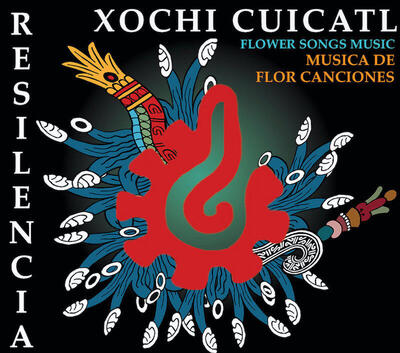Imagine what it's like to fly off a cliff into the water of a cenote in the Yucatan. Christopher Garcia has imagined such a sacrifice via ancient indigenous musical instruments, as well as a scenario 500 or more years old just before and after that moment, including a solemn ceremony, a chase to the brink, ghostly underwater voices, and a final pouring out accompanied by communal prayer. And that's just the first 18 minutes.
Primarily a drummer who has performed many kinds of improvised music worldwide since the '70s, Garcia offers "Resiliencia" as a follow-up to 2020's "Resonancia," another remarkable delve into the implications of Mesoamerican history and sound. Both collections include tracks featuring the penetrating voices of Garcia's archaeologist daughter, Alegria Garcia, and wife, Yolanda Evelia Delgado Garcia.
The palette of "Resiliencia," recorded with impressive clarity and creative use of the stereo field, strikes the ear with its variety. One might describe the sounds as novel, except that they are novel only to modern urban ears: Garcia has acquired replicas of ancient drums, flutes, ocarinas and other instruments, and learned to play and blend them for maximum effect in his own compositions, since, though we know how they sounded, we can only guess at the original music's structure and function.
In the opening suite and in the 10-minute "Yolteotl (The Arc of a Life)," Garcia often returns to the basics of heartbeat and breath, while layering on complexities of idea and emotion with rapid metallic percussion or a nerve-shattering gong or the kind of hair-raising flute harmonies that could not be found in Western notation. Similar harmonies sometimes also arise when Alegria and Yolanda are singing Pirekua indigenous music from Michoacan.
The Garcias' historical-preservational work continues to moving effect with two versions (first in 16th-century Mexica-Azteca Nahuatl, then in Spanish) of the classic ballad "La Llorona," sung from the viewpoint of a woman who has lost her children. The accompanying text suggests that the song's legend may have been adapted from omens predicting the disastrous arrival of Cortez -- the story of a goddess mourning the murder of her children by an invader was rewritten to portray an indigenous woman killing her own children, thus exculpating the Spaniards.
This music would be spellbinding even if you didn't learn a thing. And ultimately, the sound is the message, with or without words. You can feel where it comes from.
* * *
Asked a couple of questions about the sounds and harmonies by email, Christopher Garcia had a few comments:
some of the flutes are clay and multi chambered,
meaning that each tube has a different tuning
and a different number of holes for each chamber
but they are physically connected to each other
but when "sounded" together a 4th voice appears
have experienced this in real time with an elder who was playing a triple flute
and a 4th voice appeared but when it was recorded only 3 voices were heard
and not the 4th
my wife and daughter were with me and when the 4th voice appeared they gave me
that "how is that happening" look on their faces
when I asked him about it he told me
"we have the instruments,
we know what they sound like,
but we don't know what they were used for
or why that happens............."
the 4th movement
VOCES IN EL VIENTRE DE LA TIERRA
was surprised (?) to hear what I heard when I LISTENED back to it
as most of the sounds are just me breathing or imitating the reverberations
of sound which occur when in a cave, and there are things that are there
which were definitely not INTENTIONED
and I cannot say where they come from and when speaking to an elder about it
they just smile and tell me......
"it's in the blood......'
* * *
Listen/buy here. Proceeds go to an indigenous-arts organization.

